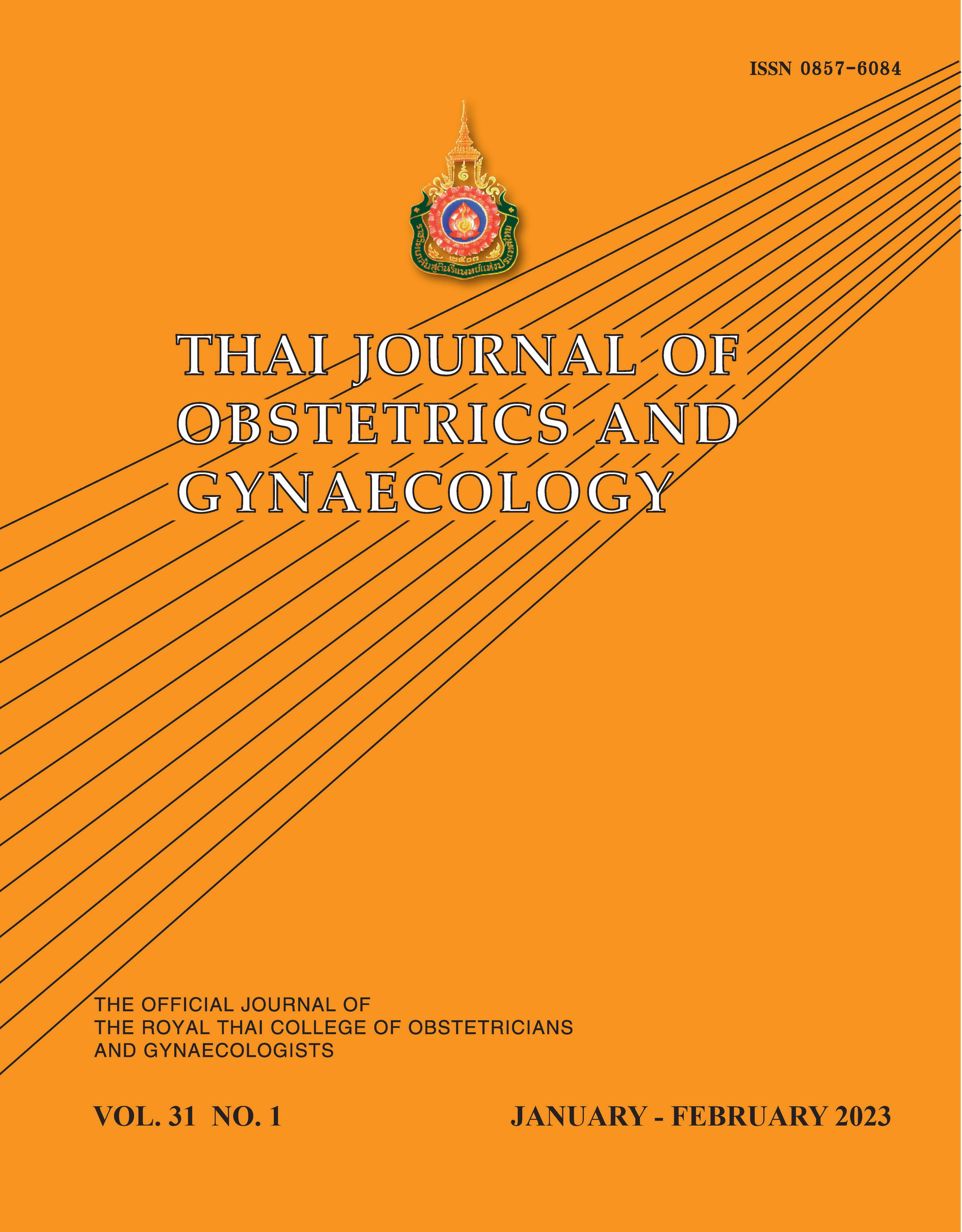Vaginal Bleeding Patterns in Women with Heart Disease Who Used Contraceptive Implants in Songklanagarind Hospital
Main Article Content
Abstract
Objectives: The primary objective was to evaluate the vaginal bleeding patterns of women with heart disease who used contraceptive implants. The secondary objectives were to compare the results with healthy women (no underlying disease) and evaluate the rates and reasons for discontinuation.
Materials and Methods: A retrospective study was conducted at Songklanagarind Hospital from January 1, 2008 to December 31, 2017. The patients who used contraceptive implants were divided into two groups: women with heart disease and healthy women. The patterns of vaginal bleeding, discontinuation rate and reasons of discontinuation were recorded and compared.
Results: A total of 263 women who used contraceptive implants included 54 (20.5%) women with heart disease. Levonorgestrel implants were used most frequently (92.6%). The rate of abnormal vaginal bleeding was significantly higher in women with heart disease (94.4% vs 71.3%, p < 0.01). Abnormal vaginal bleeding patterns were irregular bleeding (33.3%), no bleeding (33.3%), and prolonged bleeding (14.8%). Women with heart disease (53.7%) who used anticoagulants had similar frequencies of overall abnormal vaginal bleeding patterns as the non-users of anticoagulants (95.8% vs 93.3%, p = 1.00). The discontinuation rates of contraceptive implants in women with heart disease were significantly lower than in healthy women (14.8% vs 29.7%, p = 0.048). The most common reason for discontinuation in women with heart disease was abnormal vaginal bleeding (62%).
Conclusion: The continuation rates of contraceptive implants in women with heart disease were high. The abnormal vaginal bleeding rate was 94.4%, especially irregular bleeding and no bleeding. Abnormal vaginal bleeding was the most common reason for discontinuation.
Article Details

This work is licensed under a Creative Commons Attribution-NonCommercial-NoDerivatives 4.0 International License.
References
Roos-Hesselink JW, Cornette J, Sliwa K, Pieper PG, Veldtman GR. Contraception and cardiovascular disease. Eur Heart J 2015;36:1728-34.
Cardiovascular Disorders. In: Cunningham FG, Leveno KJ, Bloom SL, Hauth JC, Rouse DJ, Spong CY, et al, eds. Williams Obstetrics 24th ed. New York: McGraw-Hill, 2014:973-99.
Roos-Hesselink JW, Ruys TP, Stein JI, Thilén U, Webb GD. Outcome of pregnancy in patients with structural or ischaemic heart disease: results of a registry of the European Society of Cardiology. Eur Heart J 2013;34:657-65.
Suwanrath C, Tongphanang P, Pinjaroen S, Suwanugsorn S. Validation of modified World Health Organization classification for pregnant women with heart disease in a tertiary care centre in southern Thailand. Int J Womens Health 2018;10:47-53.
Teratology, Teratogens, and Fetotoxic Agents. In: Cunningham FG, Leveno KJ, Bloom SL, Hauth JC, Rouse DJ, Spong CY, et al, eds. Williams Obstetrics 24th ed. New York: McGraw-Hill 2014:252-3.
World Health Organization. Family Planning: A global handbook for providers. 2018 ed. Geneva; 2018.
Trussell J, Aiken AR. Contraceptive efficacy. In: Hatcher RA, ed. Contraceptive Technology, 21st revised edition. New York: Ardent Media 2018:829-39.
American College of Obstetricians and Gynecologists Committee: ACOG Practice Bulletin: Long-acting reversible contraception: implants and intrauterine devices. Obstet Gynecol 2017;186:130-5.
Zingone MM, Guirguis AB, Airee A, Cobb D. Probable drug interaction between warfarin and hormonal contraceptives. Ann Pharmacother 2009;43:2096-102.
Ellison J, Thomson AJ, Greer IA, Walker ID. Drug Points: Apparent interaction between warfarin and levonorgestrel used for emergency contraception. BMJ 2000;321:1382.
Fraser IS, Critchley HO, Broder M, Munro MG. The FIGO recommendations on terminologies and definitions for normal and abnormal uterine bleeding. Semin Reprod Med 2011;29:383-90.
Lindley KJ, Madden T, Cahill AG, Ludbrook PA, Billadello J. Contraceptive use and unintended pregnancy in women with congenital heart disease. Obstet Gynaecol 2015;126:363-9.
Laine K, Yasar U, Widen J, Tybring G. A screening study on the liability of eight different female sex steroids to inhibit CYP2C9, 2C19 and 3A4 activities in human liver microsomes. Pharmacol Toxicol 2003;93:77-81.
Vieira CS, Ferriani RA, Garcia AA, Pintão MC, Azevedo GD, Gomes MKO, et al. Use of the etonogestrel-releasing implant is associated with hypoactivation of the coagulation cascade. Hum Reprod 2007;22:2196-201.
Kemmeren JM, Algra A, Meigers JCM, Bouma BN, Grobbee DE. Effects of second and third generation oral contraceptives and their respective progestagens on the coagulation system in the absence or presence of factor V Leiden mutation. Thromb Haemost 2002;87:199-205.
Bahamondes L, Brache V, Meirik O, Ali M, Habib N, Landoulsi S, et al. A 3 year multicentre randomized controlled trial of etonogestrel- and levonorgestrel-releasing contraceptive implants, with non-randomized matched copper-intrauterine device controls. Hum Reprod 2015;30:2527-38.


